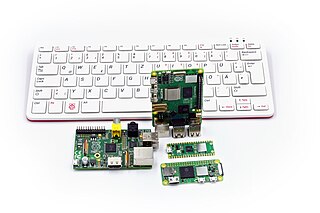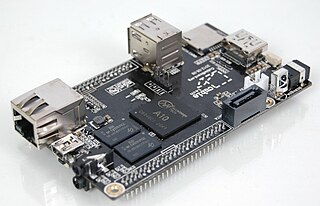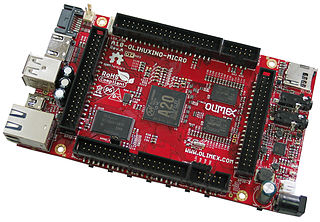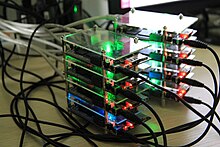The i.MX range is a family of Freescale Semiconductor proprietary microcontrollers for multimedia applications based on the ARM architecture and focused on low-power consumption. The i.MX application processors are SoCs (System-on-Chip) that integrate many processing units into one die, like the main CPU, a video processing unit, and a graphics processing unit for instance. The i.MX products are qualified for automotive, industrial, and consumer markets. Most of them are guaranteed for a production lifetime of 10 to 15 years.
Devices that use i.MX processors include Ford Sync, the Amazon Kindle and Kobo eReader series of e-readers until 2021, Zune, Sony Reader, Onyx Boox readers/tablets, SolidRun SOM's, Purism's Librem 5, some Logitech Harmony remote controls and Squeezebox radio and some Toshiba Gigabeat MP4 players. The i.MX range was previously known as the "DragonBall MX" family, the fifth generation of DragonBall microcontrollers. i.MX originally stood for "innovative Multimedia eXtension".

The BeagleBoard is a low-power open-source single-board computer produced by Texas Instruments in association with Digi-Key and Newark element14. The BeagleBoard was also designed with open source software development in mind, and as a way of demonstrating the Texas Instrument's OMAP3530 system-on-a-chip. The board was developed by a small team of engineers as an educational board that could be used in colleges around the world to teach open source hardware and software capabilities. It is also sold to the public under the Creative Commons share-alike license. The board was designed using Cadence OrCAD for schematics and Cadence Allegro for PCB manufacturing; no simulation software was used.
Rockchip is a Chinese fabless semiconductor company based in Fuzhou, Fujian province. Rockchip has been providing SoC products for tablets & PCs, streaming media TV boxes, AI audio & vision, IoT hardware since founded in 2001. It has offices in Shanghai, Beijing, Shenzhen, Hangzhou and Hong Kong. It designs system on a chip (SoC) products, using the ARM architecture licensed from ARM Holdings for the majority of its projects.

The PandaBoard was a low-power single-board computer development platform based on the Texas Instruments OMAP4430 system on a chip (SoC). The board has been available to the public at the subsidized price of US$174 since 27 October 2010. It is a community supported development platform.

The ARM Cortex-A15 MPCore is a 32-bit processor core licensed by ARM Holdings implementing the ARMv7-A architecture. It is a multicore processor with out-of-order superscalar pipeline running at up to 2.5 GHz.

Raspberry Pi is a series of small single-board computers (SBCs) developed in the United Kingdom by the Raspberry Pi Foundation in association with Broadcom. Since 2013, Raspberry Pi devices have been developed and supported by a subsidiary of the Raspberry Pi Foundation, now named Raspberry Pi Ltd. The Raspberry Pi project originally leaned toward the promotion of teaching basic computer science in schools. The original model became more popular than anticipated, selling outside its target market for diverse uses such as robotics, home and industrial automation, and by computer and electronic hobbyists, because of its low cost, modularity, open design, and its adoption of the HDMI and USB standards.

The ARM Cortex-A7 MPCore is a 32-bit microprocessor core licensed by ARM Holdings implementing the ARMv7-A architecture announced in 2011.

The Allwinner A1X is a family of single-core SoC devices designed by Allwinner Technology from Zhuhai, China. Currently the family consists of the A10, A13, A10s and A12. The SoCs incorporate the ARM Cortex-A8 as their main processor and the Mali 400 as the GPU.
The MK802 is a PC-on-a-stick produced by Rikomagic, a Chinese company using mostly two series of systems on a chip architectures:

Allwinner Technology Co., Ltd is a fabless semiconductor company that designs mixed-signal systems on a chip (SoC). The company is headquartered in Zhuhai, Guangdong, China. It has a sales and technical support office in Shenzhen, Guangdong, and logistics operations in Hong Kong.

HiSilicon is a Chinese fabless semiconductor company based in Shenzhen, Guangdong province and wholly owned by Huawei. HiSilicon purchases licenses for CPU designs from ARM Holdings, including the ARM Cortex-A9 MPCore, ARM Cortex-M3, ARM Cortex-A7 MPCore, ARM Cortex-A15 MPCore, ARM Cortex-A53, ARM Cortex-A57 and also for their Mali graphics cores. HiSilicon has also purchased licenses from Vivante Corporation for their GC4000 graphics core.

OLinuXino is an open hardware single-board computer capable of running Android or Linux designed by OLIMEX Ltd in Bulgaria.

Banana Pi is a line of single-board computers produced by the Chinese company Shenzhen SINOVOIP Company, its spin-off Guangdong BiPai Technology Company, and supported by Hon Hai Technology (Foxconn). Its hardware design was influenced by the Raspberry Pi, and both lines use the same 40-pin I/O connector.

Amlogic Inc. is a Fabless semiconductor company that was founded on March 14, 1995, in Santa Clara, California and is predominantly focused on designing and selling system on a chip integrated circuits. Like most Fabless companies in the industry, the company outsources the actual manufacturing of its chips to third-party independent chip manufacturers such as TSMC. Its main target applications as of 2021 are entertainment devices such as Android TV-based devices and IPTV/OTT set-top boxes, media dongles, smart TVs and tablets. It has offices in Shanghai, Shenzhen, Beijing, Xi'an, Chengdu, Hefei, Nanjing, Qingdao, Taipei, Hong Kong, Seoul, Mumbai, London, Munich, Indianapolis, Milan, Novi Sad and Santa Clara, California.

The Rockchip RK3288 is an ARM architecture System on Chip (SoC) from Rockchip. It is the first SoC, in August 2014, that uses the 32-bit ARM Cortex-A17 processor. It is a quad-core processor with a NEON coprocessor and hardware acceleration for video and 3D graphics. It is used in a number of Chromebooks and other low-power, low-performance devices.
CHIP was a single-board computer crowdfunded by now-defunct Next Thing Co. (NTC), released as open-source hardware running open-source software. It was advertised as "the world's first $9 computer". CHIP and related products are discontinued. NTC has since gone insolvent.
Pine Store Limited, known by its trade name Pine64, is a Hong Kong-based organization that designs, manufactures, and sells single-board computers, notebook computers, as well as smartwatch/smartphones. Its name was inspired by the mathematical constants pi and e with a reference to 64-bit computing power.

The Pinebook is a low-cost notebook developed by Hong Kong-based computer manufacturer Pine64. The Pinebook was announced in November 2016 and production started in April 2017. It is based on the platform of Pine64's existing Pine A64 single board computer, costing US$89 or US$99 for the 11.6" and 14" model respectively. Its appearance resembles the MacBook Air. The Pinebook is sold "at-cost" by Pine64 as a community service.

The PineTab is a low-cost tablet developed by Hong Kong-based computer manufacturer Pine64. The PineTab was announced in May 2020, with shipping beginning in September 2020. It is based on the platform of the existing Pine A64 single board computer, with the platform being used in related devices, such as the Pinebook and PinePhone.















